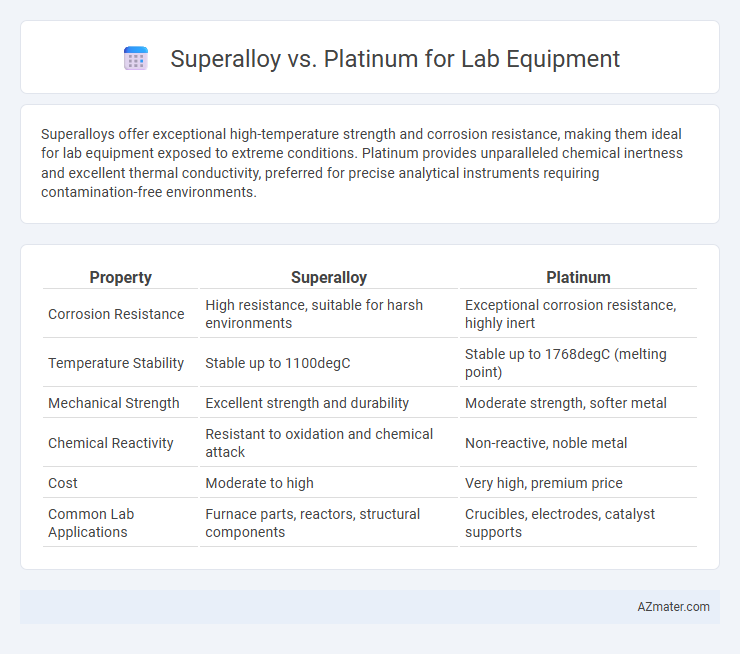Superalloys offer exceptional high-temperature strength and corrosion resistance, making them ideal for lab equipment exposed to extreme conditions. Platinum provides unparalleled chemical inertness and excellent thermal conductivity, preferred for precise analytical instruments requiring contamination-free environments.
Table of Comparison
| Property | Superalloy | Platinum |
|---|---|---|
| Corrosion Resistance | High resistance, suitable for harsh environments | Exceptional corrosion resistance, highly inert |
| Temperature Stability | Stable up to 1100degC | Stable up to 1768degC (melting point) |
| Mechanical Strength | Excellent strength and durability | Moderate strength, softer metal |
| Chemical Reactivity | Resistant to oxidation and chemical attack | Non-reactive, noble metal |
| Cost | Moderate to high | Very high, premium price |
| Common Lab Applications | Furnace parts, reactors, structural components | Crucibles, electrodes, catalyst supports |
Introduction to Superalloys and Platinum in Lab Equipment
Superalloys, known for their exceptional resistance to heat, oxidation, and corrosion, are widely used in lab equipment requiring durability and high-temperature performance, such as reactors and furnaces. Platinum, prized for its outstanding chemical inertness and catalytic properties, is commonly utilized in electrochemical sensors, crucibles, and high-precision laboratory instruments. Selecting between superalloys and platinum depends on specific application requirements, including thermal stability, chemical resistance, and budget constraints.
Material Properties: Superalloy vs Platinum
Superalloys exhibit exceptional mechanical strength, high-temperature resistance, and corrosion resistance, making them ideal for demanding lab environments requiring durability and thermal stability. Platinum offers superior chemical inertness, excellent corrosion resistance, and outstanding catalytic properties, crucial for precise analytical applications involving aggressive chemicals. While superalloys excel in structural resilience and heat endurance, platinum's key advantage lies in its unmatched chemical stability and resistance to reactive substances in laboratory settings.
Thermal Stability and Performance Comparison
Superalloys exhibit exceptional thermal stability, maintaining structural integrity at temperatures exceeding 1000degC, making them ideal for high-temperature lab equipment applications. Platinum, while offering superb corrosion resistance and stable performance up to approximately 1200degC, is softer and more prone to deformation under mechanical stress. Superalloys outperform platinum in thermal fatigue resistance, ensuring longer lifespan and consistent performance in rigorous laboratory environments.
Corrosion and Chemical Resistance
Superalloys exhibit exceptional corrosion resistance in high-temperature and aggressive chemical environments, making them ideal for lab equipment exposed to oxidizing and reducing agents. Platinum offers superior chemical inertness, resisting corrosion in most acids and bases, which ensures longevity and purity in sensitive analytical applications. Comparing the two, superalloys provide robustness under thermal stress, while platinum guarantees unparalleled chemical stability in highly reactive settings.
Cost Analysis: Superalloy vs Platinum
Superalloys offer a cost-effective alternative to platinum in lab equipment due to their lower raw material and production expenses, significantly reducing initial investment and maintenance costs. Platinum, while superior in corrosion resistance and chemical inertness, commands a premium price that can make it less feasible for budget-conscious laboratories. Evaluating long-term operational costs, superalloys provide durability and thermal stability that balance performance with affordability, making them ideal for many standard laboratory applications.
Durability and Longevity in Laboratory Settings
Superalloy materials offer superior durability and resistance to high temperatures and corrosion, making them ideal for prolonged use in harsh laboratory environments. Platinum, while highly chemically inert and resistant to oxidation, is softer and more prone to mechanical wear over time compared to superalloys. For laboratory equipment requiring extended longevity under extreme thermal and mechanical stress, superalloy components typically provide a more robust and long-lasting solution.
Application Suitability: When to Choose Superalloy or Platinum
Superalloys excel in high-temperature lab applications requiring exceptional mechanical strength and oxidation resistance, such as reactors or furnaces operating above 800degC. Platinum is preferred for chemical lab equipment exposed to highly corrosive substances and environments requiring superior chemical inertness and catalytic properties. Choosing superalloy suits conditions demanding durability under thermal stress, while platinum is optimal for precise analytical or catalytic processes where contamination must be minimized.
Maintenance Requirements and Lifespan
Superalloy lab equipment offers superior corrosion resistance and high-temperature stability, resulting in extended lifespan with minimal maintenance compared to platinum. Platinum requires regular polishing and cleaning to prevent surface contamination and maintain catalytic efficiency, leading to higher maintenance frequency. The durability of superalloys in harsh laboratory environments reduces downtime and replacement costs, making them a cost-effective choice over platinum in long-term applications.
Environmental Impact and Sustainability
Superalloys, often composed of nickel, cobalt, and chromium, offer high durability and corrosion resistance, reducing the frequency of replacement and waste generation in lab equipment. Platinum, while highly resistant to chemical corrosion and excellent for catalytic applications, involves intensive mining processes that generate significant environmental degradation and carbon emissions. Choosing superalloy materials supports sustainable lab practices by extending equipment lifespan and minimizing ecological footprints.
Conclusion: Selecting the Right Material for Lab Equipment
Selecting the right material for lab equipment depends on the specific application conditions, including temperature, chemical exposure, and budget constraints. Superalloys offer exceptional strength and corrosion resistance at high temperatures, making them ideal for extreme environments, while platinum provides unparalleled chemical inertness and stability for highly corrosive or sensitive analyses. Evaluating the operational requirements ensures optimal performance, cost-efficiency, and longevity in laboratory settings.

Infographic: Superalloy vs Platinum for Lab Equipment
 azmater.com
azmater.com